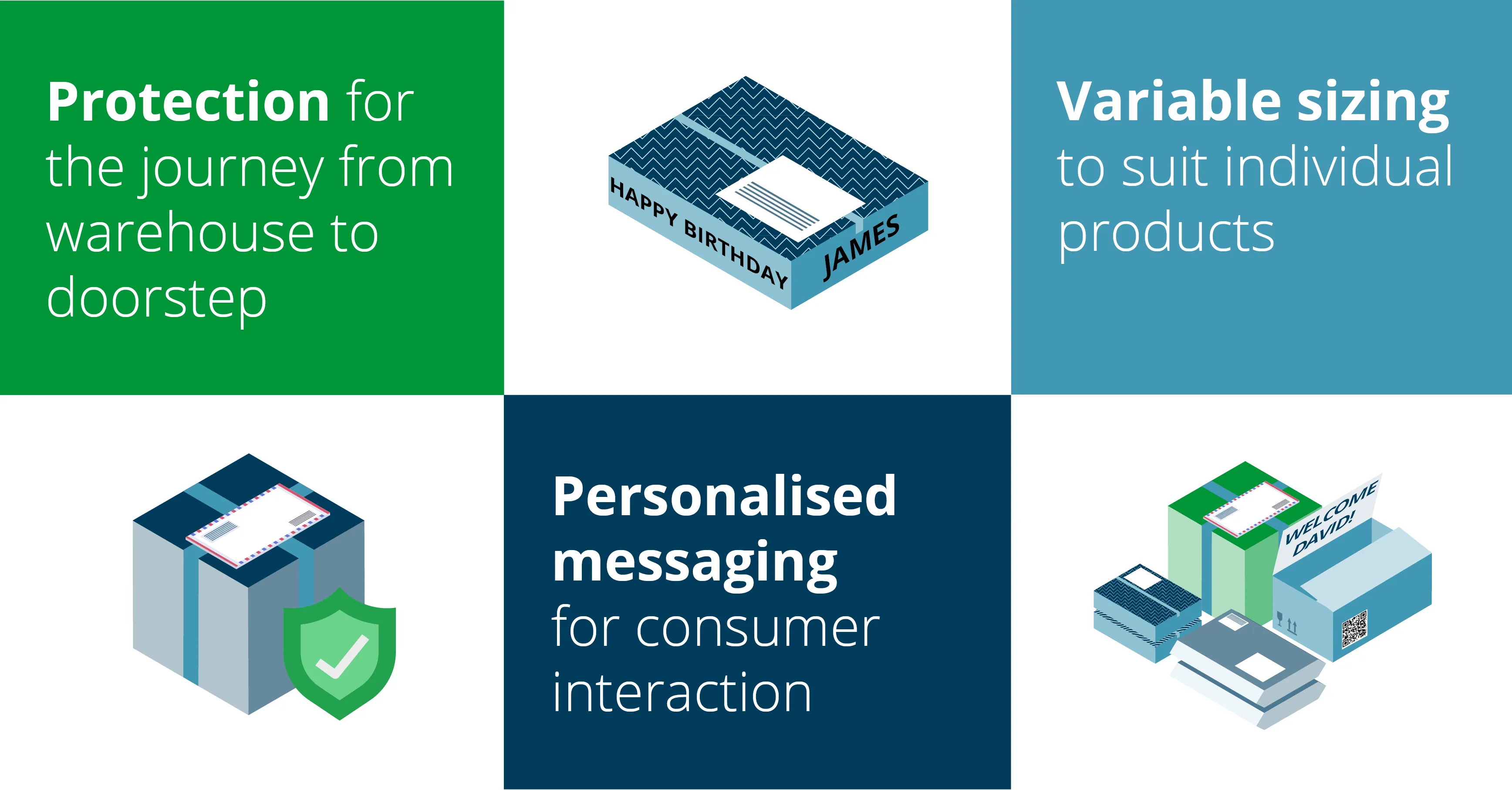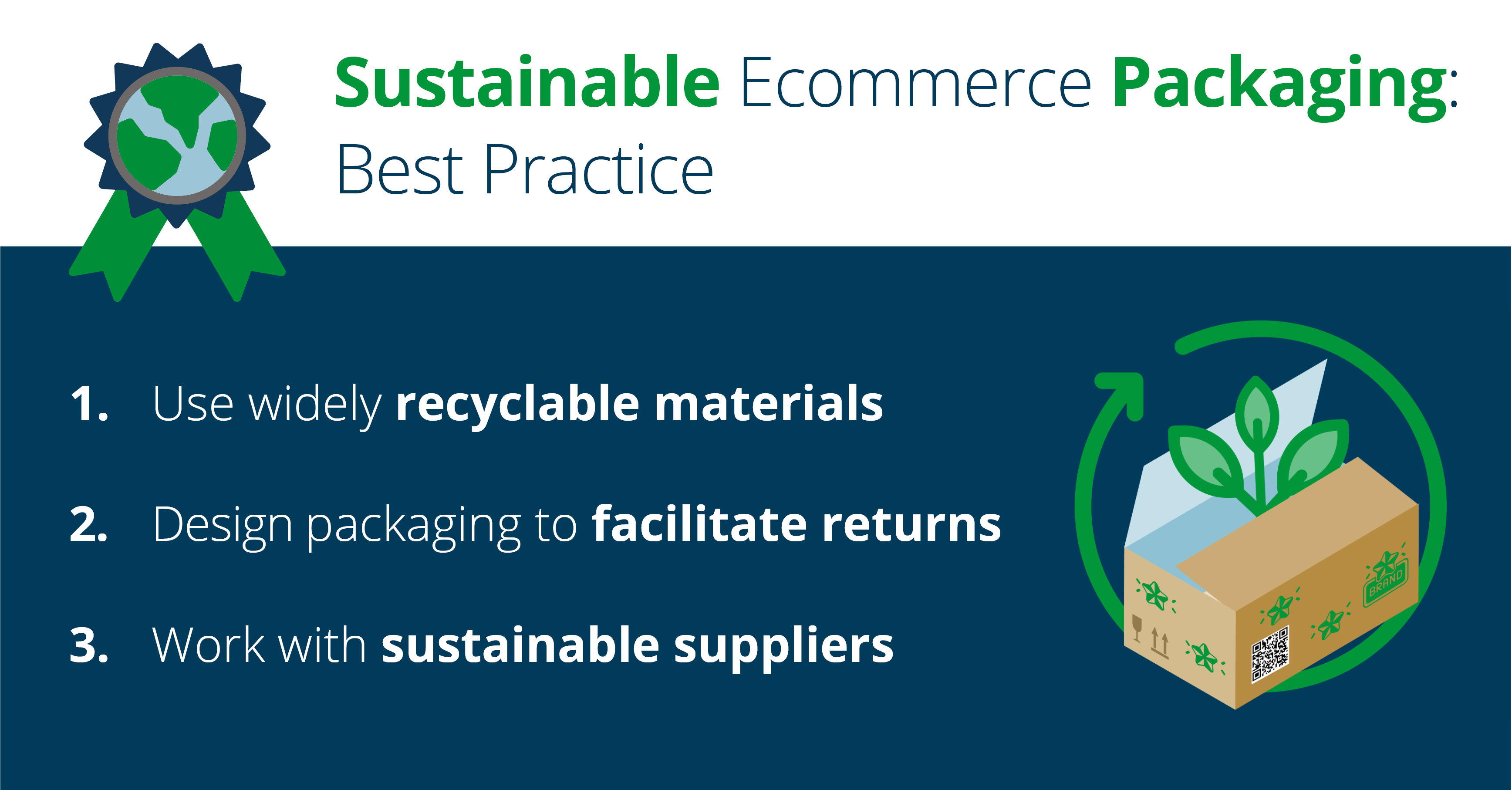In the last few decades, amid increasing consumer and governmental concerns around the impact of packaging waste, large global brands have ramped up commitments to sustainability alongside new regulations necessitating changes to product packaging designs.
Most recently, the EU introduced new rules to help curb excess packaging waste, focusing on encouraging businesses to explore reusable packaging options, limit overpackaging and empty space, and provide clear labels to support correct recycling.
However, it has been suggested that some of these new packaging requirements may be more suitable for products sold in retail stores while doing little to support the creation of sustainable packaging for products purchased online.
In this blog, we will highlight the complexities surrounding sustainable packaging design for ecommerce and provide some top tips to help brands navigate the new regulations and limit the environmental impact of their ecommerce packaging.

The ecommerce packaging landscape
Ecommerce is a huge part of global retail, with sales of approximately 5.2 trillion USD in 2021 and forecast to grow by 56% by 2026, reaching 8.1 trillion[i].
In 2021, ecommerce accounted for 159 billion shipments globally[ii]. While ecommerce has grown, so has the associated waste from shipments, often composed of single-use packaging that the end consumer may not recycle.
However, stakeholders from the European packaging industry, including business consultancy firm NOA and the European Federation of Corrugated Board Manufacturers (FEFCO), suggest that ecommerce’s contribution to packaging waste may be exaggerated because it is more visible to the end consumer. Ecommerce represents just 7% of the corrugated market in Europe[iii], with the vast majority of corrugated used for bulk shipments.
Designated changes to the EU Packaging and Packaging Waste Directive (EU PPWD) specifically target ecommerce, though they do little to consider the complexities of ecommerce supply chains. Indeed, introducing reuse targets for ecommerce (20% by 2030, increasing to 80% by 2040) may conflict directly with requirements to reduce empty space and minimise excess packaging.
Find out the difference between retail and ecommerce packaging here.
Reusable packaging in ecommerce
A reusable plastic crate may use 20-30 times more material than a single-use corrugated box and will only create less waste if reused well beyond its ‘break-even’ point. Reusable packaging must be sturdy enough to withstand reuse over time and be part of a reuse system promoting consumer behaviour change.
The complexities surrounding facilitating packaging returns in ecommerce could make it more challenging to get consumers on board.
Reuse models requiring a consumer to ‘return to store’ may be easier to facilitate when consumers are attending a physical store as part of their weekly routine. In ecommerce, where consumers enjoy the convenience of having items delivered to their doors, the requirement to post or physically return items makes it less likely that items will be reused beyond the break-even point. The picture becomes more complex once the carbon footprint of transporting reusable ecommerce packaging is considered.
In 2022, FEFCO commissioned three scientific studies comparing recyclable and reusable packaging, including a hot-spot analysis of the ecommerce value chain. The findings suggested that, in many cases, recycled packaging may be more sustainable than reusable options.
Commenting on the studies, Eleni Despotou, Director General of FEFCO, highlighted that “Expressing a clear preference for reusable versus recyclable packaging is a narrow-minded approach” and that, above all, “Legislative proposals must ensure that any packaging placed on the EU market is ‘fit for purpose,’ environmentally friendly, fulfils its functionality and prevents unnecessary waste which is the ultimate objective of policymakers.”
In October 2023, the Confederation of Paper Industries (CPI) called on the European Parliament to support the continued exemption of cardboard packaging in the revised EU PPWD. The CPI suggested that exemptions “recognise the sustainability” of cardboard packaging, and reinstating the exemption would steer the PPWD away from a ‘one-size-fits-all’ approach to packaging[iv]. In November 2023, the European Parliament voted to allow EU countries exemption from 2030 reuse targets for materials with recycling rates of over 85%[v].
Tips for creating more sustainable packaging for ecommerce

So, how can brands create ecommerce packaging that is ‘fit for purpose’?
While the most significant share of carbon emissions in ecommerce comes from the packaging itself (45%), shipping and returns make up 13% and 25%, respectively[vi]. A key focus for ecommerce should be to reduce the impact of packaging while facilitating efficient shipping and returns.
Use widely recyclable materials: Paper and cardboard packaging are easy to recycle, and already enjoy very high recycling rates. In the EU, paper and cardboard packaging recycling rates have been consistently above 80% since 2008, reaching 81.6% in 2020. By using recyclable materials, and encouraging consumers to properly dispose of packaging, brands can help to increase this figure.
Think about the end consumer: Brands can identify whether reuse or recycling is the most appropriate option by identifying how consumers are most likely to interact with the packaging. While recyclable packaging is often the best solution, there are specific models for which reusable packaging may be appropriate, for example, where high return rates are core to the service, such as meal box deliveries and leasing models for clothing or children’s toys.
Reduce materials without compromising product protection: Redesigning packaging to remove empty space and reduce materials will cut waste while allowing for more efficient shipping and logistics. Consider ‘build to fit’ solutions designed to custom-fit packaging to products and deliveries. Customising each pack to a specific delivery would help reduce transportation costs and packaging material while ensuring that items are securely packaged to prevent damage.
Optimise delivery networks: Optimising delivery schedules and encouraging collections could help to reduce individual deliveries, by encouraging consumers to ‘collect’ products from a convenient location, as part of their daily commute, for example. According to UPS, more than 90% of people in the US are within five miles of a UPS Access Point, where they can pick up products instead of receiving them at home.
Design packaging to facilitate returns: Smithers identified returns as a key priority in the future of sustainable ecommerce packaging, highlighting the importance of simplifying the returns process and streamlining logistics for the e-retailer[vii]. Brands should consider designing packaging to facilitate returns, including using QR codes to help with returns and designing packaging that can be reused to return items.
Embrace the power of 2D codes: By adding variable data codes, including QR codes powered by GS1 – previously known as the GS1 Digital Link – to product packaging, brands can facilitate greater data sharing throughout ecommerce supply chains and identify opportunities for sustainable optimisation. The same codes can be used as a consumer touchpoint to reinforce sustainability commitments further. Many consumers are already adept at scanning 2D codes to find out information about a product; QR codes powered by GS1 can ‘resolve’ themselves based on geo-location and the device being used to scan the code and have enormous potential to help consumers identify the most sustainable methods for return, reuse, and recycling, and can also give brands evidence of recycling and reuse rates.
Work with sustainable suppliers: Make sure you only consider suppliers and partners who share your commitment to sustainability.
Conclusion
With ecommerce expected to continue its growth trajectory, everyone must do their part to ensure the industry can grow sustainably. Sustainable growth will require brands to collaborate with everyone, including packaging manufacturers, coding and marking solutions providers, and global logistics partners, and to remain abreast of current and future updates to packaging legislation.
As a global coding and marking solutions provider, Domino understands the complexities involved in designing packaging for ecommerce that is both fit for purpose, and environmentally responsible, and can provide valuable insight into how brands can create additional value by adding variable data coding with 2D codes on their product packaging.
Please get in touch to find out more.
[i] Statista, 2020, https://www.statista.com/statistics/379046/worldwide-retail-e-commerce-sales/, accessed on 21st November 2023.
[ii] Pitney Bowes, 2021, https://www.pitneybowes.com/content/dam/pitneybowes/us/en/shipping-index/22-pbcs-04529-2021-global-parcel-shipping-index-ebook-web-002.pdf, accessed on 21st May 2024.
[iii] https://www.linkedin.com/posts/fefco---european-federation-of-corrugated-board-manufacturers_corrugated-deliveron-activity-6985546300549136384-Bj5u/?trk=public_profile_like_view, accessed on 21st November 2023.
[iv] CPI, 2023, https://paper.org.uk/CPI/CPI/Content/News/Press-Releases/2023/EU-Reuse-Targets-for-Transport-Packaging.aspx, accessed on 6th December 2023.
[v] Euractiv, 2023, https://www.euractiv.com/section/energy-environment/news/parliament-votes-to-water-down-eus-packaging-waste-law/, accessed on 6th December 2023.
[vi] Statista, 2020, https://www.statista.com/statistics/1254302/ecommerce-average-emissions-by-source/, accessed on 7th November 2023.
[vii] Smithers, 2023, https://www.smithers.com/en-gb/services/market-reports/packaging/future-of-sustainable-e-commerce-packaging-to-2028. accessed on 20th November 2023.